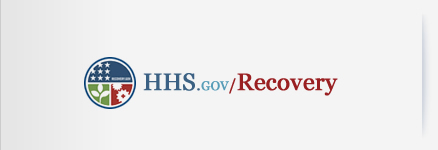Recovery Act: Wisconsin Highlights

| Since the enactment of the Recovery Act in 2009, the U.S. Department of Health and Human Services has made $2.3 billion in stimulus funds available in the State of Wisconsin* for Community Health Centers, universities and other institutions to provide fiscal relief, improve health care, expand access to health care services, provide child care and other social services for its most vulnerable citizens, establish the infrastructure for health information technology and conduct scientific research. 
|
This includes:- $1.7 billion for the increased Federal share (FMAP) of State Medicaid costs.
- $141.1 million for scientific research, facilities, and equipment, including:
- $14.9 million for cardiovascular and cardio regenerative science facilities at the University of Wisconsin, Madison.
- $125.1 million for health information technology (IT), including:
- $104.7 million for Wisconsin’s Medicaid Electronic Health Record incentive program for implementation and payments to providers and hospitals.
- $10.8 million to MetaStar Inc. to create a Regional Extension Center to provide health IT support services to doctors and other providers.
- $51 million for Temporary Assistance for Needy Families (TANF), including $4.2 million for subsidized employment programs.
- $32.8 million for Head Start and Early Head Start programs to expand service and improve quality.
- $31.1 million for the Child Care and Development Fund to increase access to child care and improve quality.
- $15.8 million for Community Health Center services, construction, renovation, equipment, and health IT, including:
- $2.8 million for Family Health Center of Marshfield for increased demand for services, equipment and construction.
- $12.3 million for the Community Services Block Grant for community action agencies to reduce poverty.
- $6 million for the Communities Putting Prevention to Work initiative for the Wisconsin Department of Health Services for community-based obesity prevention programs in La Crosse and Wood counties; $4.7 million for State efforts targeting obesity and tobacco; and $1 million for the Great Lakes Inter-Tribal Council for tobacco prevention activities.
- $3.8 million for immunization programs.
- $3.7 million through the Indian Health Service, including funds from the EPA, for health facilities construction, equipment, sanitation facilities and maintenance and health IT.
- $3.2 million to support 66 National Health Service Corps clinicians providing primary health care in Health Professional Shortage Areas.
- $1.9 million for meals and nutrition services for the elderly at home and in community settings.
*The total funding in this document is based on the HHS Sept. 30, 2011, Financial and Activity Report (FAR) for the Recovery Act, available at the Department’s website, http://www.hhs.gov/recovery/reports/index.html, except for FMAP, which is based on the Oct. 21, 2011, FAR and FMAP obligations of $216 million in Recovery Act funds extended by P.L. 111-226. The highlights are a selection of programs funded by the Recovery Act and do not add up to the total funding within the State. For more information about individual HHS programs and Recovery Act funding, see http://www.hhs.gov/recovery/. Last Updated: November 18, 2011 |









